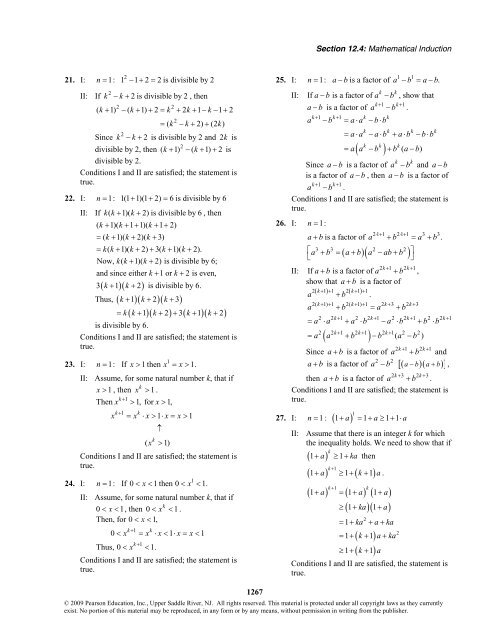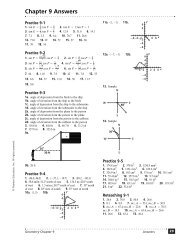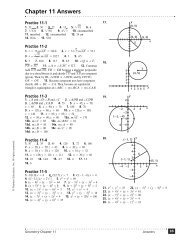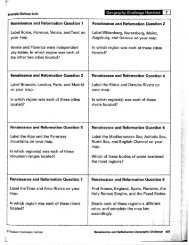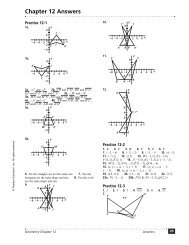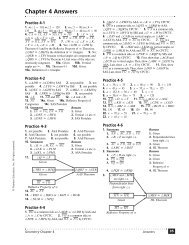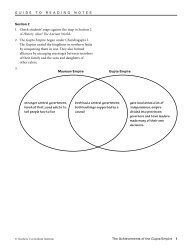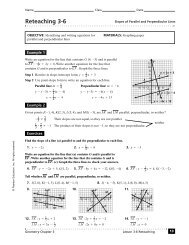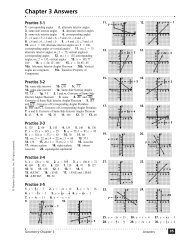Chapter 12 Sequences; Induction; the Binomial Theorem
Chapter 12 Sequences; Induction; the Binomial Theorem
Chapter 12 Sequences; Induction; the Binomial Theorem
You also want an ePaper? Increase the reach of your titles
YUMPU automatically turns print PDFs into web optimized ePapers that Google loves.
Section <strong>12</strong>.4: Ma<strong>the</strong>matical <strong>Induction</strong><br />
21. I:<br />
2<br />
n = 1: 1 − 1+ 2 = 2 is divisible by 2<br />
2<br />
II: If k − k + 2 is divisible by 2 , <strong>the</strong>n<br />
2 2<br />
( k + 1) − ( k+ 1) + 2= k + 2k+ 1−k− 1+<br />
2<br />
2<br />
= ( k − k+ 2) + (2 k)<br />
2<br />
Since k − k + 2 is divisible by 2 and 2k is<br />
2<br />
divisible by 2, <strong>the</strong>n ( k + 1) − ( k + 1) + 2 is<br />
divisible by 2.<br />
Conditions I and II are satisfied; <strong>the</strong> statement is<br />
true.<br />
22. I: n = 1: 1(1 + 1)(1 + 2) = 6 is divisible by 6<br />
23. I:<br />
24. I:<br />
II: If kk ( + 1)( k+ 2) is divisible by 6 , <strong>the</strong>n<br />
( k + 1)( k+ 1+ 1)( k+ 1+<br />
2)<br />
= ( k + 1)( k+ 2)( k+<br />
3)<br />
= kk ( + 1)( k+ 2) + 3( k+ 1)( k+<br />
2).<br />
Now, kk ( + 1)( k+<br />
2) is divisible by 6;<br />
and since ei<strong>the</strong>r k + 1 or k + 2 is even,<br />
3( k + 1)( k + 2)<br />
is divisible by 6.<br />
Thus, ( k + 1)( k+ 2)( k+<br />
3)<br />
= k k+ 1 k+ 2 + 3 k+ 1 k+<br />
2<br />
( )( ) ( )( )<br />
is divisible by 6.<br />
Conditions I and II are satisfied; <strong>the</strong> statement is<br />
true.<br />
n= 1: If x > 1<strong>the</strong>n x = x > 1.<br />
II: Assume, for some natural number k, that if<br />
k<br />
x > 1 , <strong>the</strong>n x > 1 .<br />
k + 1<br />
Then x > 1, for x > 1,<br />
k+<br />
1 k<br />
x = x ⋅ x > 1⋅ x = x > 1<br />
↑<br />
k<br />
( x > 1)<br />
Conditions I and II are satisfied; <strong>the</strong> statement is<br />
true.<br />
n= 1: If 0 < x< 1<strong>the</strong>n 0 < x < 1.<br />
II: Assume, for some natural number k, that if<br />
k<br />
0< x < 1, <strong>the</strong>n 0< x < 1.<br />
Then, for 0 < x < 1,<br />
k+<br />
1 k<br />
0< x = x ⋅ x< 1⋅ x = x<<br />
1<br />
k + 1<br />
Thus, 0 < x < 1.<br />
Conditions I and II are satisfied; <strong>the</strong> statement is<br />
true.<br />
1<br />
1<br />
25. I:<br />
1 1<br />
n= 1: a−bis a factor of a − b = a−<br />
b.<br />
II: If a− b is a factor of a − b , show that<br />
a− b is a factor of a − b .<br />
k+ 1 k+<br />
1 k k<br />
a − b = a⋅a −b⋅b<br />
= aa ⋅ −ab ⋅ + ab ⋅ −bb<br />
⋅<br />
k k k<br />
= a a − b + b ( a−b)<br />
k<br />
( )<br />
k<br />
k+ 1 k+<br />
1<br />
k k k k<br />
Since a− b is a factor of a − b and a−<br />
b<br />
is a factor of a− b, <strong>the</strong>n a− b is a factor of<br />
a<br />
k+ 1 k+<br />
1<br />
− b .<br />
Conditions I and II are satisfied; <strong>the</strong> statement is<br />
true.<br />
26. I: n = 1:<br />
21 ⋅+ 1 21 ⋅+ 1 3 3<br />
a+ bis a factor of a + b = a + b .<br />
⎡ 3 3 2 2<br />
a + b = ( a+ b)( a − ab+<br />
b )<br />
⎤<br />
⎣<br />
⎦<br />
II:<br />
k<br />
k<br />
2k+ 1 2k+<br />
1<br />
If a+ b is a factor of a + b ,<br />
show that a+ b is a factor of<br />
2( k+ 1) + 1 2( k+ 1)<br />
+ 1<br />
a + b .<br />
2( k+ 1) + 1 2( k+ 1) + 1 2k+ 3 2k+<br />
3<br />
a + b = a + b<br />
= a ⋅ a + a ⋅b −a ⋅ b + b ⋅b<br />
2 2k+ 1 2k+ 1 2k+<br />
1 2 2<br />
= a a + b −b ( a −b<br />
)<br />
2 2k+ 1 2 2k+ 1 2 2k+ 1 2 2k+<br />
1<br />
( )<br />
2k+ 1 2k+<br />
1<br />
Since a+ b is a factor of a + b and<br />
2 2<br />
a+ b is a factor of a − b [( a− b)( a+ b)<br />
] ,<br />
2k+ 3 2k+<br />
3<br />
<strong>the</strong>n a+ b is a factor of a + b .<br />
Conditions I and II are satisfied; <strong>the</strong> statement is<br />
true.<br />
27. I: 1<br />
n = : ( ) 1<br />
1+ a = 1+ a ≥ 1+ 1⋅<br />
a<br />
II: Assume that <strong>the</strong>re is an integer k for which<br />
<strong>the</strong> inequality holds. We need to show that if<br />
k<br />
1+ a ≥ 1+ ka <strong>the</strong>n<br />
( )<br />
k + 1<br />
( 1+ a) ≥ 1+ ( k+ 1)<br />
a.<br />
k+<br />
1<br />
k<br />
( 1+ a) = ( 1+ a) ( 1+<br />
a)<br />
≥ ( 1+ ka)( 1+<br />
a)<br />
2<br />
= 1+ ka + a + ka<br />
= 1+ k+ 1 a+<br />
ka<br />
( )<br />
( k )<br />
≥ 1+ + 1 a<br />
Conditions I and II are satisfied, <strong>the</strong> statement is<br />
true.<br />
2<br />
<strong>12</strong>67<br />
© 2009 Pearson Education, Inc., Upper Saddle River, NJ. All rights reserved. This material is protected under all copyright laws as <strong>the</strong>y currently<br />
exist. No portion of this material may be reproduced, in any form or by any means, without permission in writing from <strong>the</strong> publisher.


